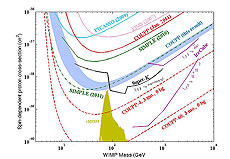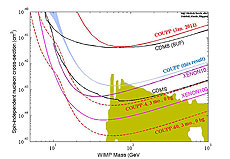Hunting for dark matter

COUPP made significant progress in the search for spin-dependent interactions of dark matter, where the dark matter couples to the spin of the target nucleus. The x-axis represents the mass of a dark matter particle, while the y-axis measures the likelihood of having an interaction. COUPP is currently the most sensitive direct detection experiment for spin-dependent dark matter.

This shows the COUPP-4 detector's sensitivity to spin-independent dark matter, where the dark matter couples to the entire nucleus regardless of its spin. Until recently, the COUPP collaboration was not competitive in this field, but with the acoustic discrimination, that is changing.
The hunt for missing mass in the universe is heating up, with some experiments reporting potential dark matter signals, while others are reporting null results in apparent conflict with those signals. Recently, the Fermilab-based Chicagoland Observatory for Underground Particle Physics (COUPP) collaboration completed a dark matter search at the deep underground site, SNOLAB, in Ontario, Canada. With the results from this search, COUPP improved their previous limits on dark matter by more than a factor of 10. They can now rule out part of the region where other experiments appear to have seen a signal.
To conduct a dark matter search, COUPP utilizes a technology deeply rooted in Fermilab's past - the bubble chamber. A bubble chamber consists of a fluid heated beyond its boiling point, or superheated, but is unable to boil without a rough surface on which to form bubbles.
In such a superheated fluid, bubbles can form due to the passage of energetic particles. Twenty years ago, Fermilab operated a 15 foot bubble chamber, now displayed in front of SiDet, to detect particles produced in high-energy collisions. Nowadays, COUPP uses a bubble chamber in a different way to look for very rare interactions.
A challenge for experimenters in this field is that dark matter will produce, at most, a handful of events per year in a detector. Unfortunately, radiation is everywhere, and a sensitive detector will see a billion irrelevant, or background, events every year. This is where the bubble chamber is put to use in the search. A major source of these background events are gamma rays, which interact with electrons in the detector. By judicious choice of operating parameters, the bubble chamber can be rendered effectively blind to electronic interactions, while maintaining sensitivity to a true dark matter event. As a result, COUPP scientists do not even see one of the biggest backgrounds for dark matter detectors.
Until recently, another background caused by a second type of radiation known as alpha decay was indistinguishable from a real signal. In 2008, scientists working on the PICASSO dark matter experiment found that they could tell alpha decays apart from true signal events by listening to the sound a bubble makes when it is formed. In the NuMI tunnel in 2009, COUPP physicists confirmed this in their bubble chamber - alpha decays sound about four times louder. With this knowledge, the physicists can separate the true signal events from the alpha decays.
Another source of background interference comes from cosmic rays, high-energy particles coming from the atmosphere. To eliminate this source of background, the COUPP collaboration moved a detector to the SNOLAB site about 6,800 feet underground where it is shielded by the earth from these cosmic rays.
The COUPP-4 detector has taken data at SNOLAB site since the fall of 2010. That data has provided two tantalizing pieces of information. First, the discrimination against alpha background events is very strong, better than 99 percent. Unfortunately, the second thing COUPP discovered was the sensors that convert sound into an electronic signal and filter out the alpha decays contain a small amount of radioactive material that is producing yet another type of background event - neutrons.
The next steps are to install new components that generate fewer background events on the COUPP-4 detector underground and to move a larger detector, COUPP-60, from the NuMI tunnel to a new home at SNOLAB. With the improved detectors, COUPP should be able to address both the controversy surrounding the recent dark matter results and challenge the current leaders in the dark matter field.
—Hugh Lippincott
|